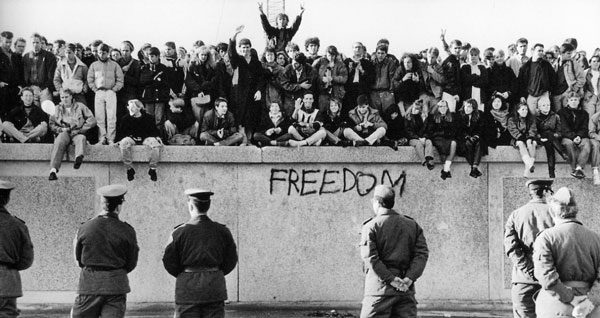In August 1961, the army of East Germany closed the border between East and West Berlin, beginning the construction of the Berlin Wall. Below are some interesting facts about the Berlin Wall that you may not know.
After World War II, the western part of Germany was controlled by the United States, France, and Britain, known as the Federal Republic of Germany; the area controlled by the Soviet Union was called the German Democratic Republic (East Germany). Not only was East and West Germany divided, but the city of Berlin was also separated. Although Berlin was located on Soviet territory, the US, France, and Britain insisted that it be divided equally among the four nations—West Berlin was controlled by the three allies, while East Berlin was under Soviet control.

The Berlin Wall – a living witness of a bygone era; Source: surfnetkids.com
From 1949 to 1961, more than 2 million East Germans fled to West Germany. In August 1961 alone, it was estimated that East Germany lost about 2,000 citizens each day, due to its weak economy and the government’s failure to meet the essential needs of life; citizens were not allowed to own land or engage in free trade, leading to increasing dissatisfaction.
Many of those fleeing were skilled workers or professionals, making their emigration particularly devastating to the East German economy. To “stem the bleeding,” Soviet leader Nikita Khrushchev advised East Germany to cut off access between the two sides. Thus, on August 13, 1961, East Germany closed the border between East and West Berlin to construct a barrier to prevent citizens from defecting to West Germany.
The construction of the Berlin Wall was a secret operation led by Erich Honecker. Only about 20 government officials were aware of the wall’s construction. The rest of the population and the government were informed that it was “a military exercise.” Little to no information about the wall’s construction was disclosed. The public believed that the wall was erected by the police to help control crowds.
Initially, a hastily arranged barrier was established, and the wall in the city center was made of people and armored vehicles. Later, East German soldiers set up barbed wire along a street called Friedrich-Ebert Strasse to create a temporary wall. Over time, the Berlin Wall was built to a height of 4 meters and stretched 107 kilometers, with some sections reaching up to 4.5 meters high, topped with barbed wire, making it nearly impossible to climb over. The wall cut through more than 190 streets in East Berlin.
Opposite East Berlin were illuminated control areas, and anyone approaching these areas was shot without warning. A trench was dug on the other side of the wall to prevent vehicles from attempting to drive through. In front of the trench were patrol posts, guard dogs, lookout towers, and shelters. A second wall was constructed in front of the first for increased security. Armed guards patrolled along the wall, ready to shoot anyone attempting to cross.
The Berlin Wall was known by many names such as “Anti-Fascist Protection Rampart,” “The Wall of Shame,” “The Inner German Border,” and “Iron Curtain.” However, it did not stop everyone from trying to escape. To reach West Berlin, many citizens, primarily university students, dug tunnels under the Berlin Wall. The cemetery was the site of the first tunnel that could be utilized.
People brought flowers and staged funerals to disguise their tunneling efforts. The cemetery tunnel was discovered when a woman pushing a stroller fell into it. The tunnel was subsequently sealed and never used again. One of the tunnels, located in the basement of house number 60 Westerstrasse, helped 29 people escape to West Berlin. Other escape attempts included hot air balloons and 5,000 people climbing over the wall.

The Berlin Wall – a major focus of media attention; Source: wearethemighty.com
According to the Potsdam Contemporary History Institute and the Berlin Wall Foundation, from 1961 to 1989, over 140 people were killed or died at the wall. While many were shot by armed soldiers, others died in a series of suicides following failed escape attempts, bizarre accidents, and drownings. Perhaps the strangest death was the last recorded on August 3, 1989, when an individual died in a failed attempt to cross using a hot air balloon.
Along the Berlin Wall, there were several checkpoints where individuals with the proper documents could cross between the sides. Among these was the Friedrichstrasse Checkpoint—commonly known as Checkpoint Charlie—featured in the James Bond films “Octopussy” and John le Carré’s “The Spy Who Came In From The Cold.” The US military maintained Checkpoint Charlie, which was the only checkpoint that allowed foreigners and allied forces to pass into East Germany.
Checkpoint Charlie also became famous as it was the site for prisoner exchanges. The most notable exchange occurred in 1962 on the Glienicke Bridge, just a short distance from Checkpoint Charlie. In this exchange, American U-2 pilot Francis Gary Powers was swapped for Rudolf Abel, a convicted Soviet spy.
When Hungary allowed people from Western Europe to enter their country, the open border of Hungary permitted citizens from socialist countries and East Berlin residents to travel freely to the West. Protests began in the German city of Leipzig, pressuring the government to liberate its people. On November 9, 1989, Gunter Schabowski, head of the East Berlin Communist Party, announced that people could travel to West Berlin.
Upon hearing this announcement, crowds gathered at various locations to break down the wall, with some keeping pieces of the debris as souvenirs. By July 1, 1990, East and West Berlin were unified, allowing free movement for everyone. Today, pieces of the Berlin Wall are being sold on eBay. Interested parties can own a sample of material from this historic wall for 0.99 euros plus shipping and handling.


















































